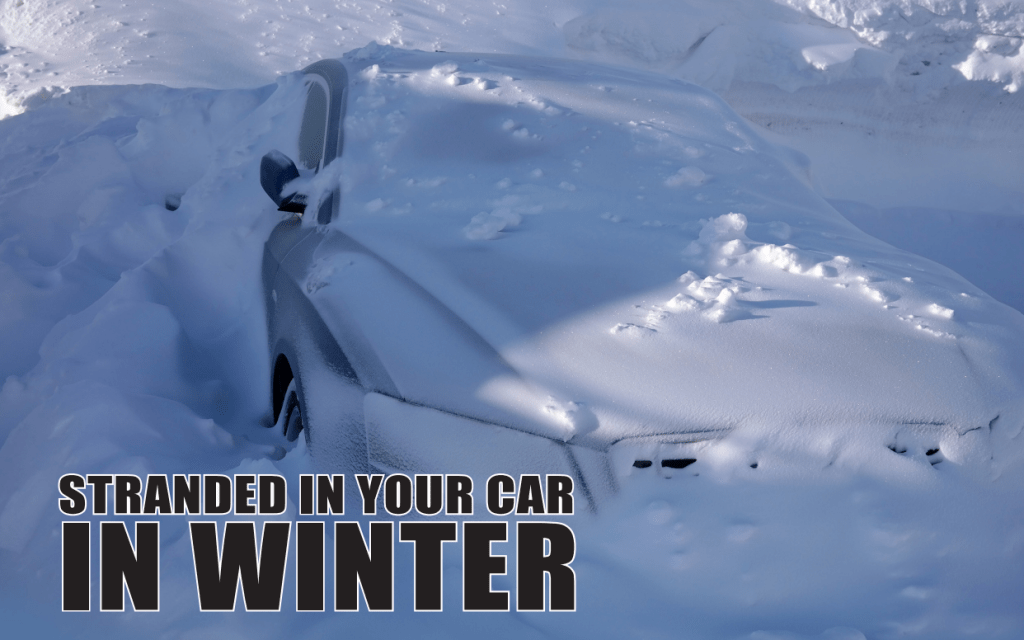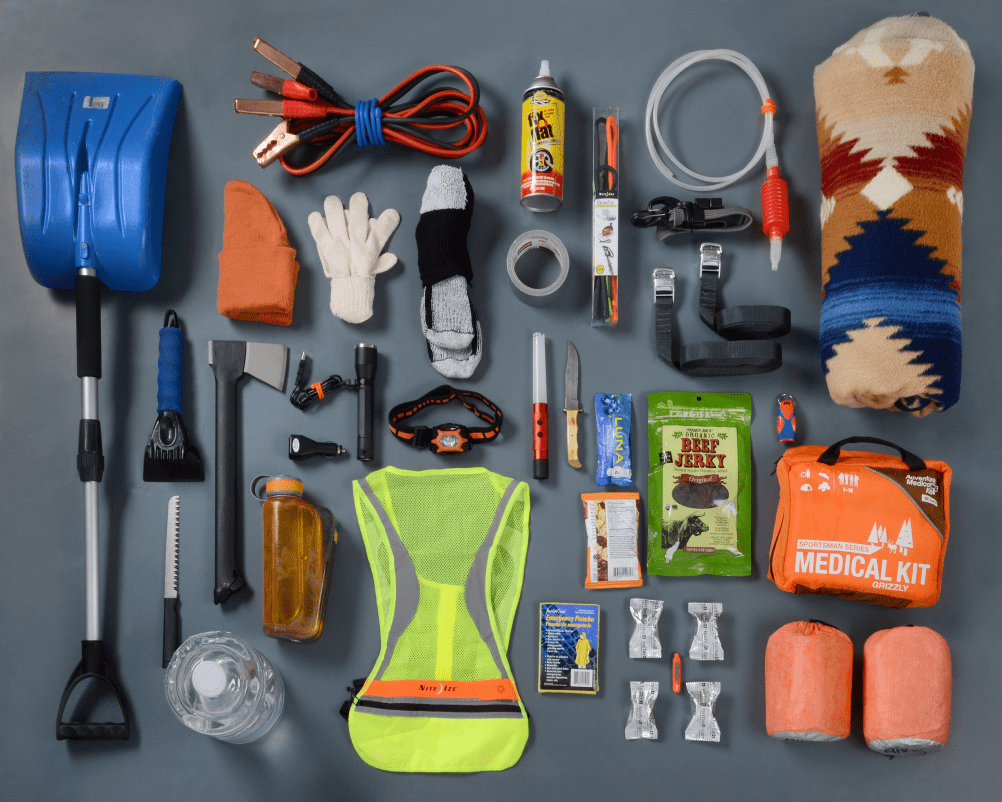Get uncensored intel and commentary from Survival Dispatch News
Subscribe to our RUMBLE channel
 What to do if you’re stranded in a car during a winter storm is a popular winter survival topic. It makes sense as our cars are the most used form of transportation. Unlike the summer, we are more likely to be in our cars when an emergency strikes during winter. Most folks don’t wander off into the wilderness in a winter storm.
What to do if you’re stranded in a car during a winter storm is a popular winter survival topic. It makes sense as our cars are the most used form of transportation. Unlike the summer, we are more likely to be in our cars when an emergency strikes during winter. Most folks don’t wander off into the wilderness in a winter storm.
But we all will drive through it.
Prepping Beforehand
There are numerous articles out there on how to survive being stranded in your car in a winter storm. They’re almost all the same. However, I feel they leave out some very important information. The first thing to consider when preparing to travel by car is having your car prepped for the journey. As a member of the Insider you have access to the calendar that gives reminders of when to prep for this very thing.
When winter is approaching we should have our vehicles prepped for emergencies before they happen. If you live in an area where snowfall is common, you should already have a kit placed in each vehicle. There are the obvious things, like changing out the tires and having snow tires put on. A set of chains should be stored in the trunk or tool box of the truck bed. I would also highly recommend a snow shovel and a tow strap. A marker panel is a good idea and can be found on Amazon. They’re a blaze orange panel that can be attached to your car’s radio antenna.
How People Get Stranded
Usually when people are caught in a storm it’s because they accidently drove off the road and get stuck. The other most common mistake is traveling through unfamiliar areas and getting onto roads that aren’t used in times of heavy snow. Your GPS won’t know what roads to avoid due to snowfall. Google will lead you out onto a forest logging road in the blink of an eye. So, the simple solutions is to know where you’re going. Look into your planned routes and have alternates. Make sure they’re maintained roads that are actually passible.
Staying In
You’ve looked into your route and have avoided wandering off into the wilderness on a logging road. But you’ve still found yourself stranded in a winter storm… What should you do now? First and foremost, stay with your car! All too often when people become stranded they panic and feel the need to walk out. Sadly, a lot of these people will either die in their attempt or suffer severe frostbite and hypothermia.
Now that you’ve accepted the fact your car is stuck and not going anywhere, it’s time to put your plan into action. Your car’s emergency kit should contain a sleeping bag for every person. I would add a couple of wool blankets as well. They can be used to insulate the windows by draping over an open door and closing it. Proper footware and gloves should also be in the kit. Heavy wool socks for everyone is very important to prevent frostbite.
Running the Car
Run your car for about ten minutes every hour. With your windows covered with blankets and everyone in a sleeping bag, it will help to keep you warm. Make sure you get out and use your snow shovel to clear the exhaust pipe. If it becomes clogged with snow it will lead to carbon monoxide poisoning and you’ll not even know it’s happening. If you run the engine, make sure that exhaust is cleared.
Heating the Car
Don’t run the car so often that you burn all of your gas. You may need it later to drive away when the weather improves or rescue arrives. Keep in mind your car can quickly turn into a refrigerator, so have another plan if it looks like you’re going to be there for a while. While the car seems like the most logical shelter, you need a way to heat it. Burning candles and camping stoves in the car is dangerous. These too can lead to carbon monoxide poisoning and should be avoided. Not to mention only one careless moment could result in the car being engulfed in flames.
Fire Building
There is a safe way you can heat your car with fire. Tools to build a fire should be in your emergency kit as well. A small folding saw and maybe a hatchet or axe if you have the room. Lighters, matches, and a firesteel along with prepared tinder should be included in your kit. Open the doors on one side of the vehicle and build a fire outside the car. Construct a reflector behind the fire to direct the heat into the car. This can be done by stacking logs or hanging a space blanket up as a reflector. Just keep the fire far enough away from the car so there’s no danger of setting your shelter on fire.
By doing this you will have a source of heat and a signal. Having the fire will also provide a psychological boost. You will be actively working to improve your survival situation. The effort to collect wood will help warm you and so will maintaining the fire. It also allow you to melt snow for water and cook food.
Water
Keep a metal container in your car. A pot or water bottle will allow you to melt snow for water. Eating snow should always be avoided except under certain circumstances. The only time it’s okay to eat snow is when you’re outside working to improve your survival situation and need to avoid sweating. Sweating and wet clothes will almost always lead to hypothermia. So eat a little snow only if you’re outside sweating and need to lower your core temperature. But first unzip your coat and remove layers as eating snow should be a last resort.
If you’re in an area of heavy snowfall you may not need to keep water in your car. Have a plan on how to melt and store snow. If snow isn’t common, then you need to store water. The rule of one gallon per person still holds here and you should plan on 72 hours. If temps routinely drop below freezing then throwing a plastic jug into the truck isn’t going to cut it as they’ll swell and burst. A cooler is a good way to keep them from freezing. Plus if the bottles did rupture, it would capture the spill.
Food
Food is the other item we need in our kit. In sub-freezing environments keeping canned goods or even MREs is a bad idea. Neither of these should ever be frozen. You can always carry freeze dried camping meals, just have a plan to cook them. Things like beef jerky, nuts, protein bars, and the like are good no cook options. As are the lifeboat rations that are available. While the latter isn’t the most appetizing option, they’ll certainly keep you alive.
The act of digestion generates heat and helps to keep you warm. So a good way to stay warm when stranded is to have a belly full of calorie dense food. Your internal furnace will go to work and generate some heat. Here again, the lifeboat rations are perfect this. No cooking required and very calorie dense. Be sure to keep plenty of food in the vehicle kit so everyone can stay fed until rescue.
Hand Warmers
A last-ditch heat source are hand warmers. These are cheap and effective. Keeping a box of them in the truck is a great idea. We have to shift our ideas of warmth in situations such as being stranded in your car. It’s not so much about keeping the space warm as it is the person. We need to warm the person and not the space. Putting hand warmers in your coat or sleeping bag is a very effective method to add warmth. You can put them inside your gloves or in shoes as well. They last for hours and can prevent frostbite.
Don’t Get Restless
By now you’ve improved your car shelter by adding blankets over the windows. You’ve built a fire with a reflector and it’s keeping everyone warm inside. The marker panel has been hung from the radio antenna so you can be seen. At this point you may start to get a little restless and think why isn’t anyone coming? You may start thinking about walking to find help. DON’T! Your best bet is to stay with the car. Continue to use your cellphone to try and reach help. If you can’t get a call out, try sending texts. They will continue to be sent until they go through and it uses far less bandwidth.
Staying with your car greatly increases the chances of rescue. It reduces the chance of cold related injuries and your car is a very valuable asset to keep with you. In a worst case scenario, you can cannibalize the car for everything from shelter material to insulation. You can even use the fuel for fire in an extreme emergency. Plus the spare tire would make a fantastic signal fire because it creates thick black smoke. Just puncture the tire first or you risk a serious explosion.
Conclusion
I cannot emphasis enough how important it is to have your car prepared before you travel in winter weather. Your kit needs to be stocked and in place. Let someone know where you’ll be, what route you’ll take, and any likely alternates. This is one of the best things you can do for yourself ahead of time. If something goes wrong, someone will let rescuers know where you’re most likely to be. Keep your head, stay calm.
If you’re prepared for this it will be nothing more than an inconvenience.
 The Kit:
The Kit:
- Snow tires
- Tire chains
- Tow strap
- Snow shovel
- Sleeping bag for each person
- Couple of wool blankets
- Metal container
- Water (1 gallon per person)
- Food such as lifeboat rations, jerky, nuts, candy bars, freeze dried meals
- Coats, boots, socks, gloves.
- Don’t forget your head! Beanies or other warm hats
- Fire kit
- Folding saw and hatchet
- Roll of TP (This will make life much more comfortable)
- Flashlights and LED lantern
- Marker panel
- Flares (For signaling and emergency fire starting)
- Hand warmers
This article was originally published in Survival Dispatch Insider magazine Volume 1 Issue 4.
=====
Become a Survival Dispatch Insider …
We bring together survival enthusiasts and preppers to share skills and knowledge, so you can enhance your preparedness for emergencies and ensure the safety of you and your community.
The Results You’ll Get …
Our community, courses, and memberships are pretty special. We focus on the ways it will make a huge difference in your life.
Here are a few of the things you’ll be able to do as a member of Survival Dispatch Insider …
1) Improve your emergency preparedness by learning survival skills and strategies from experienced preppers.
2) Build lasting connections with like-minded individuals that share your passion for safety and readiness.
3) Access a wealth of knowledge and resources to assist in protecting you and your community during unexpected situations.
Click HERE to get started.
=====
